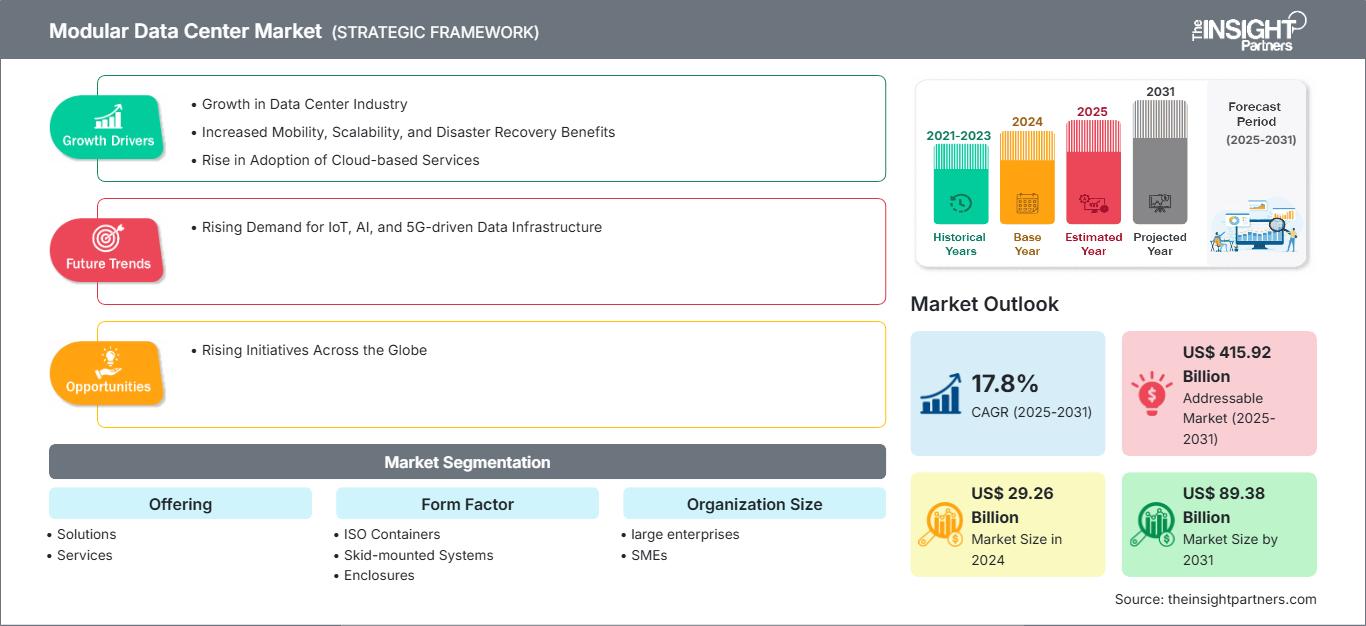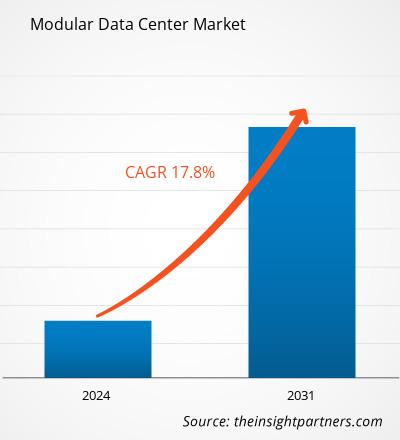Der Markt für modulare Rechenzentren wurde im Jahr 2024 auf 29,26 Milliarden US-Dollar geschätzt und soll bis 2031 89,38 Milliarden US-Dollar erreichen; für den Zeitraum 2025–2031 wird eine durchschnittliche jährliche Wachstumsrate (CAGR) von 17,8 % erwartet. Die steigende Nachfrage nach IoT-, KI- und 5G-basierter Dateninfrastruktur dürfte im Prognosezeitraum ein wichtiger Markttrend sein.
Marktanalyse für modulare Rechenzentren
Das globale Wachstum des Marktes für modulare Rechenzentren wurde durch deren Vorteile in Bezug auf Mobilität, Skalierbarkeit und Notfallwiederherstellung vorangetrieben. Diese Innovationen sollen schnelle und flexible Lösungen bieten, die Unternehmen die Bereitstellung von IT-Systemen ermöglichen. Unternehmen benötigen Sicherheit hinsichtlich der Betriebskontinuität und der Fähigkeit, sich von potenziellen Störungen zu erholen. Der Markt bietet verschiedene Lösungen mit robusten Strukturen, die leicht verlagert oder erweitert werden können, um den spezifischen Anforderungen eines Unternehmens gerecht zu werden. Diese Flexibilität ist entscheidend für die Aufrechterhaltung der Geschäftskontinuität bei Katastrophen oder anderen unvorhergesehenen Ereignissen und gewährleistet den Schutz ihrer Daten und Anwendungen.
Marktübersicht für modulare Rechenzentren
Ein modulares Rechenzentrum ist ein skalierbarer und flexibler Ansatz für die Verwaltung der IT-Infrastruktur, bei dem einzelne Komponenten oder Module vorgefertigte Einheiten sind, die bei Bedarf zusammengebaut und erweitert werden können. Im Gegensatz zu herkömmlichen Rechenzentren, die große, zentralisierte Bauprojekte erfordern, werden modulare Rechenzentren aus standardisierten Einheiten gebaut, die schnell bereitgestellt und angepasst werden können. Diese Modularität ermöglicht es Unternehmen, ihre Kapazität im Laufe der Zeit ohne nennenswerte Unterbrechungen oder hohe Vorabinvestitionen zu erweitern. Modulare Rechenzentren bieten mehrere wichtige Vorteile. Sie sind skalierbar und ermöglichen es Unternehmen, ihre Datenverarbeitungskapazität entsprechend ihrem wachsenden Bedarf zu erhöhen. Das macht sie besonders wertvoll für Unternehmen mit schnellem Wachstum oder schwankender Nachfrage. Der modulare Aufbau stellt außerdem sicher, dass Unternehmen ihre IT-Infrastruktur schrittweise erweitern können, wodurch unnötige Kosten minimiert und eine Überbereitstellung vermieden wird. Die Nachfrage nach flexiblen und portablen Lösungen steigt, da Unternehmen bestrebt sind, sich an die sich entwickelnden Marktanforderungen anzupassen. Modulare Rechenzentren ermöglichen Unternehmen die bedarfsgerechte Erweiterung ihrer Infrastruktur mit weniger Ausfallzeiten im Vergleich zu herkömmlichen Rechenzentren. Diese Flexibilität ist besonders vorteilhaft für Branchen wie den Einzelhandel, wo die Nachfrage schwankt, oder für Unternehmen, die neue Märkte erschließen. Da Flexibilität und schnelle Reaktion für den Geschäftserfolg unerlässlich sind, werden modulare Rechenzentren zunehmend als wertvolles Kapital angesehen, das Unternehmen hilft, Herausforderungen effektiv zu meistern und ihre Abläufe zu optimieren.
Passen Sie diesen Bericht Ihren Anforderungen an
Sie erhalten kostenlos Anpassungen an jedem Bericht, einschließlich Teilen dieses Berichts oder einer Analyse auf Länderebene, eines Excel-Datenpakets sowie tolle Angebote und Rabatte für Start-ups und Universitäten.
Markt für modulare Rechenzentren: Strategische Einblicke

-
Holen Sie sich die wichtigsten Markttrends aus diesem Bericht.Dieses KOSTENLOSE Beispiel umfasst Datenanalysen, die von Markttrends bis hin zu Schätzungen und Prognosen reichen.
Markttreiber und -chancen für modulare Rechenzentren
Wachstum der Rechenzentrumsbranche
Die Rechenzentrumsbranche hat im letzten Jahrzehnt ein erhebliches Wachstum erlebt, das durch den steigenden Datenverbrauch, die Einführung der Cloud und die Verbreitung von IoT-Geräten getrieben wurde. Laut JLL erlebt die Rechenzentrumsbranche im September 2024 eine überwältigende Nachfrage seitens der Nutzer. Bis Mitte 2024 hatte die verfügbare Kapazität an Colocation-Rechenzentren in den USA 12 GW erreicht und sich damit seit 2020 verdoppelt, mit einer durchschnittlichen jährlichen Wachstumsrate von 21 %. Nord-Virginia ist weiterhin der größte Markt und macht fast die Hälfte des Kapazitätsausbaus seit 2020 aus. Damit übertrifft es andere Regionen bei weitem. Die Märkte im Süden und Westen der USA verzeichnen jedoch ein schnelleres Wachstum. Da Organisationen und Unternehmen ihre digitale Infrastruktur weiter ausbauen, ist der Bedarf an effizienter und zuverlässiger Verwaltung komplexer IT-Systeme gestiegen. Dies hat zu einer wachsenden Nachfrage nach modularen Rechenzentren geführt, die eine zentrale Rolle für die nahtlose Verwaltung des Rechenzentrumsbetriebs spielen.
Steigende Nutzung cloudbasierter Dienste
Regierungen und große Unternehmen priorisieren die Implementierung fortschrittlicher Cloud-Lösungen und -Anwendungen. Führende Branchenakteure konzentrieren sich auf die Entwicklung hochmoderner modularer Rechenzentren mit immersiven Technologien zur Verwaltung riesiger Datenmengen. So stellte Vertiv, ein weltweit führendes Unternehmen für kritische digitale Infrastruktur- und Kontinuitätslösungen, im Juli 2025 den Vertiv MegaMod CoolChip vor, eine vorgefertigte modulare (PFM) Rechenzentrumslösung mit Flüssigkeitskühlung, die effizientes und zuverlässiges KI-Computing unterstützen soll. Diese Lösung kann an Plattformen führender KI-Computing-Anbieter angepasst und entsprechend den Kundenanforderungen skaliert werden. Durch die Kombination des hochwertigen, prozesseffizienten Ansatzes der Offsite-Fertigung mit fortschrittlichen KI-fähigen Technologien kann der MegaMod CoolChip die Bereitstellungszeit für KI-kritische digitale Infrastrukturen um bis zu 50 % reduzieren.
Segmentierungsanalyse des Marktberichts für modulare Rechenzentren
Schlüsselsegmente, die zur Ableitung der Marktanalyse für modulare Rechenzentren beigetragen haben, sind Angebot, Lösungen, Formfaktor, Unternehmensgröße und Branche.
- In Bezug auf das Angebot ist der Markt in Lösungen und Dienstleistungen unterteilt.
- Basierend auf Lösungen ist der Markt in vorgefertigte Module und All-in-One-Lösungen segmentiert.
- In Bezug auf den Formfaktor ist der Markt in ISO-Container, Skid-montierte Systeme und Gehäuse unterteilt.
- Auf Grundlage der Unternehmensgröße ist der Markt in KMU und Großunternehmen unterteilt.
- Nach Branchen ist der Markt in IT und Telekommunikation, BFSI, Regierung, Gesundheitswesen, Fertigung, Medien und Unterhaltung unterteilt andere.
Marktanteilsanalyse modularer Rechenzentren nach Geografie
- Der Markt für modulare Rechenzentren ist in fünf große Regionen unterteilt: Nordamerika, Europa, Asien-Pazifik (APAC), Naher Osten und Afrika (MEA) sowie Süd- und Mittelamerika. Nordamerika dominierte den Markt im Jahr 2024, gefolgt von Europa und dem Asien-Pazifik-Raum.
- Der Markt für modulare Rechenzentren in Nordamerika ist in die USA, Kanada und Mexiko unterteilt. Die schnelle Ausbreitung datenintensiver Anwendungen und des Cloud-Computing hat zu einem erheblichen Anstieg der Anzahl von Rechenzentren in der Region geführt. Laut der CBRE North America Data Center Trend Analysis 2024 befinden sich die sieben größten Rechenzentrumsmärkte Nordamerikas in den USA, d. h. in Nord-Virginia, Dallas/Fort Worth, Silicon Valley, Chicago, Phoenix, der New York Tri-State Area und Atlanta. Die schnelle Einführung von Cloud-Computing, IoT, KI und 5G-Technologien treibt die Nachfrage nach skalierbaren und effizienten Rechenzentren in Nordamerika an. Diese Technologien erfordern eine robuste, flexible und zuverlässige Infrastruktur, weshalb modulare Rechenzentren die ideale Lösung darstellen. Sie bieten die nötige Skalierbarkeit für wachsende Datenmengen und ermöglichen Unternehmen, ihre Infrastruktur schnell an veränderte Anforderungen anzupassen.
- Der Bedarf an latenzarmer, lokaler Datenverarbeitung wird immer wichtiger, insbesondere mit dem Aufkommen von IoT- und Echtzeit-Datenanwendungen. Modulare Rechenzentren bieten eine Lösung, indem sie Unternehmen die Bereitstellung kleinerer, geografisch verteilter Einheiten ermöglichen, die die Latenz reduzieren und die Leistung verbessern. Dies ist besonders wichtig in Branchen wie der Automobilindustrie, dem Gesundheitswesen und der Fertigung, in denen Echtzeit-Datenverarbeitung für die betriebliche Effizienz entscheidend ist. Ebenso ist der wachsende Trend zum Edge Computing in Nordamerika ein wichtiger Treiber für die Einführung modularer Rechenzentren. Da Unternehmen nach mehr Rechenleistung näher an der Datenquelle streben, bieten modulare Rechenzentren die Flexibilität und die schnellen Bereitstellungsmöglichkeiten, die für Edge-Computing-Anwendungen erforderlich sind.
- Vertiv Group, Schneider Electric und Emerson sind einige der führenden Unternehmen auf dem europäischen Markt für modulare Rechenzentren. Diese Anbieter ergreifen verschiedene Initiativen zur Entwicklung modularer Rechenzentren. Im November 2024 hat Schneider Electric, der Marktführer in der digitalen Transformation von Energiemanagement und Automatisierung, die Fertigungs- und Produktionskapazität seines vorgefertigten Rechenzentrumswerks in Barcelona deutlich von 7.000 m2 auf 12.000 m2 erhöht. Damit reagierte das Unternehmen auf die gestiegene Kundennachfrage nach vorgefertigten Rechenzentrumslösungen für hohe Rechenlasten. Das Werk und das große Logistikzentrum in Sant Boi de Llobregat, Barcelona – einem der wichtigsten Standorte in Europa für Design, Produktion und Integration des EcoStruxure Modular Data Centre-Portfolios von Schneider Electric – bieten zusätzliche 5.000 m2 dedizierte Produktionsfläche und erfüllen so die gestiegenen Kundenanforderungen nach schneller Markteinführung, Vorhersehbarkeit und belastbaren Rechenzentrumslösungen.
Regionale Einblicke in den Markt für modulare Rechenzentren
Die Analysten von The Insight Partners haben die regionalen Trends und Faktoren, die den Markt für modulare Rechenzentren im Prognosezeitraum beeinflussen, ausführlich erläutert. In diesem Abschnitt werden auch die Marktsegmente und die geografische Lage modularer Rechenzentren in Nordamerika, Europa, im asiatisch-pazifischen Raum, im Nahen Osten und Afrika sowie in Süd- und Mittelamerika erörtert.
Umfang des Marktberichts zu modularen Rechenzentren
| Berichtsattribut | Einzelheiten |
|---|---|
| Marktgröße in 2024 | US$ 29.26 Billion |
| Marktgröße nach 2031 | US$ 89.38 Billion |
| Globale CAGR (2025 - 2031) | 17.8% |
| Historische Daten | 2021-2023 |
| Prognosezeitraum | 2025-2031 |
| Abgedeckte Segmente |
By Angebot
|
| Abgedeckte Regionen und Länder |
Nordamerika
|
| Marktführer und wichtige Unternehmensprofile |
|
Dichte der Marktteilnehmer für modulare Rechenzentren: Auswirkungen auf die Geschäftsdynamik verstehen
Der Markt für modulare Rechenzentren wächst rasant. Die steigende Nachfrage der Endnutzer ist auf Faktoren wie veränderte Verbraucherpräferenzen, technologische Fortschritte und ein stärkeres Bewusstsein für die Produktvorteile zurückzuführen. Mit der steigenden Nachfrage erweitern Unternehmen ihr Angebot, entwickeln Innovationen, um den Bedürfnissen der Verbraucher gerecht zu werden, und nutzen neue Trends, was das Marktwachstum weiter ankurbelt.

- Holen Sie sich die Markt für modulare Rechenzentren Übersicht der wichtigsten Akteure
Neuigkeiten und aktuelle Entwicklungen zum Markt für modulare Rechenzentren
Der Markt für modulare Rechenzentren wird durch die Erhebung qualitativer und quantitativer Daten aus Primär- und Sekundärforschung bewertet, die wichtige Unternehmenspublikationen, Verbandsdaten und Datenbanken umfasst. Einige der Entwicklungen auf dem Markt für modulare Rechenzentren sind unten aufgeführt:
- Eaton und CTS Nordics – ein Unternehmen, das Rechenzentren plant und baut – errichten eine neue NordicEPOD-Anlage in Oslo. Die hochmoderne Anlage von NordicEPOD produziert jetzt standardisierte Strommodule, sogenannte EPODs, die die Bauzeit von Rechenzentren um Wochen verkürzen.
(Quelle: Eaton, Pressemitteilung, 2025)
- Schneider Electric, der weltweit führende Anbieter im Bereich der digitalen Transformation von Energiemanagement und Automatisierung, hat in Red Oak, Texas, eine neue 105.000 Quadratmeter große Integrationsanlage eröffnet. Dort wird vorgefertigte modulare Infrastruktur gebaut, um die wachsende Nachfrage nach neuen Rechenzentren in den gesamten USA zu decken.
(Quelle: Schneider Electric, Pressemitteilung, 2024)
Bericht zum Markt für modulare Rechenzentren: Abdeckung und Ergebnisse
Der „Markt für modulare Rechenzentren – Größe und Prognose (2021–2031)“ bietet eine detaillierte Analyse des Marktes, die die unten genannten Bereiche abdeckt:
- Marktgröße und Prognose für modulare Rechenzentren auf globaler, regionaler und Länderebene für alle abgedeckten wichtigen Marktsegmente
- Markttrends für modulare Rechenzentren sowie Marktdynamik wie Treiber, Einschränkungen und wichtige Chancen
- Detaillierte PEST- und SWOT-Analyse
- Marktanalyse für modulare Rechenzentren, die wichtige Markttrends, globale und regionale Rahmenbedingungen, wichtige Akteure, Vorschriften und aktuelle Marktentwicklungen umfasst
- Branchenlandschafts- und Wettbewerbsanalyse, die Marktkonzentration, Heatmap-Analyse, prominente Akteure und aktuelle Entwicklungen für den Markt für modulare Rechenzentren umfasst
- Detaillierte Unternehmensprofile
- Historische Analyse (2 Jahre), Basisjahr, Prognose (7 Jahre) mit CAGR
- PEST- und SWOT-Analyse
- Marktgröße Wert/Volumen – Global, Regional, Land
- Branchen- und Wettbewerbslandschaft
- Excel-Datensatz
Aktuelle Berichte
Verwandte Berichte
Erfahrungsberichte
Grund zum Kauf
- Fundierte Entscheidungsfindung
- Marktdynamik verstehen
- Wettbewerbsanalyse
- Kundeneinblicke
- Marktprognosen
- Risikominimierung
- Strategische Planung
- Investitionsbegründung
- Identifizierung neuer Märkte
- Verbesserung von Marketingstrategien
- Steigerung der Betriebseffizienz
- Anpassung an regulatorische Trends






















 Kostenlose Probe anfordern für - Markt für modulare Rechenzentren
Kostenlose Probe anfordern für - Markt für modulare Rechenzentren